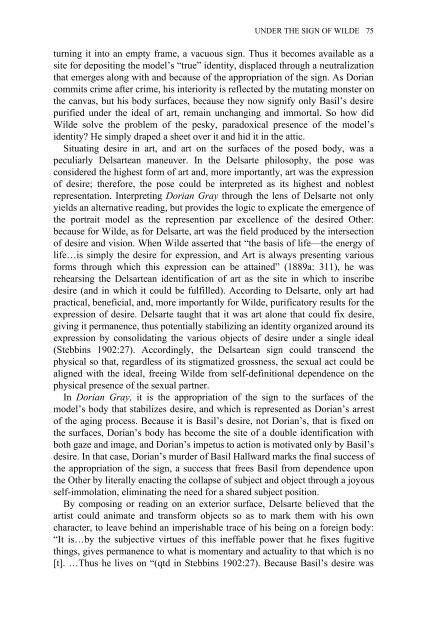Edited by Moe Meyer - Get a Free Blog
Edited by Moe Meyer - Get a Free Blog
Edited by Moe Meyer - Get a Free Blog
Create successful ePaper yourself
Turn your PDF publications into a flip-book with our unique Google optimized e-Paper software.
UNDER THE SIGN OF WILDE 75<br />
turning it into an empty frame, a vacuous sign. Thus it becomes available as a<br />
site for depositing the model’s “true” identity, displaced through a neutralization<br />
that emerges along with and because of the appropriation of the sign. As Dorian<br />
commits crime after crime, his interiority is reflected <strong>by</strong> the mutating monster on<br />
the canvas, but his body surfaces, because they now signify only Basil’s desire<br />
purified under the ideal of art, remain unchanging and immortal. So how did<br />
Wilde solve the problem of the pesky, paradoxical presence of the model’s<br />
identity? He simply draped a sheet over it and hid it in the attic.<br />
Situating desire in art, and art on the surfaces of the posed body, was a<br />
peculiarly Delsartean maneuver. In the Delsarte philosophy, the pose was<br />
considered the highest form of art and, more importantly, art was the expression<br />
of desire; therefore, the pose could be interpreted as its highest and noblest<br />
representation. Interpreting Dorian Gray through the lens of Delsarte not only<br />
yields an alternative reading, but provides the logic to explicate the emergence of<br />
the portrait model as the represention par excellence of the desired Other:<br />
because for Wilde, as for Delsarte, art was the field produced <strong>by</strong> the intersection<br />
of desire and vision. When Wilde asserted that “the basis of life—the energy of<br />
life…is simply the desire for expression, and Art is always presenting various<br />
forms through which this expression can be attained” (1889a: 311), he was<br />
rehearsing the Delsartean identification of art as the site in which to inscribe<br />
desire (and in which it could be fulfilled). According to Delsarte, only art had<br />
practical, beneficial, and, more importantly for Wilde, purificatory results for the<br />
expression of desire. Delsarte taught that it was art alone that could fix desire,<br />
giving it permanence, thus potentially stabilizing an identity organized around its<br />
expression <strong>by</strong> consolidating the various objects of desire under a single ideal<br />
(Stebbins 1902:27). Accordingly, the Delsartean sign could transcend the<br />
physical so that, regardless of its stigmatized grossness, the sexual act could be<br />
aligned with the ideal, freeing Wilde from self-definitional dependence on the<br />
physical presence of the sexual partner.<br />
In Dorian Gray, it is the appropriation of the sign to the surfaces of the<br />
model’s body that stabilizes desire, and which is represented as Dorian’s arrest<br />
of the aging process. Because it is Basil’s desire, not Dorian’s, that is fixed on<br />
the surfaces, Dorian’s body has become the site of a double identification with<br />
both gaze and image, and Dorian’s impetus to action is motivated only <strong>by</strong> Basil’s<br />
desire. In that case, Dorian’s murder of Basil Hallward marks the final success of<br />
the appropriation of the sign, a success that frees Basil from dependence upon<br />
the Other <strong>by</strong> literally enacting the collapse of subject and object through a joyous<br />
self-immolation, eliminating the need for a shared subject position.<br />
By composing or reading on an exterior surface, Delsarte believed that the<br />
artist could animate and transform objects so as to mark them with his own<br />
character, to leave behind an imperishable trace of his being on a foreign body:<br />
“It is…<strong>by</strong> the subjective virtues of this ineffable power that he fixes fugitive<br />
things, gives permanence to what is momentary and actuality to that which is no<br />
[t]. …Thus he lives on “(qtd in Stebbins 1902:27). Because Basil’s desire was


